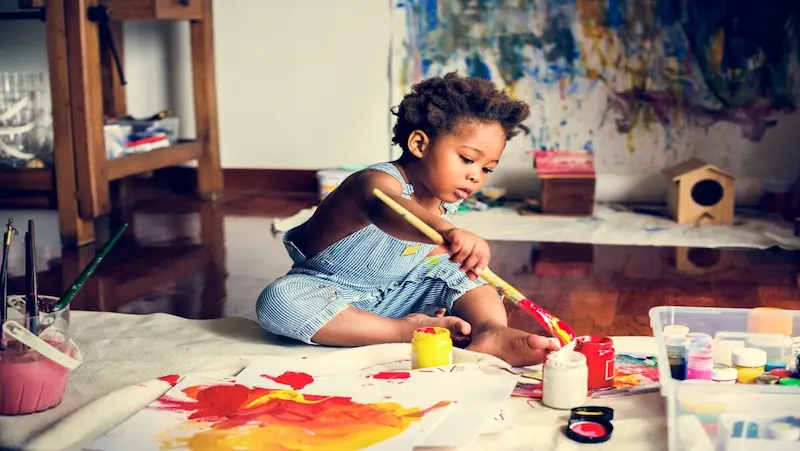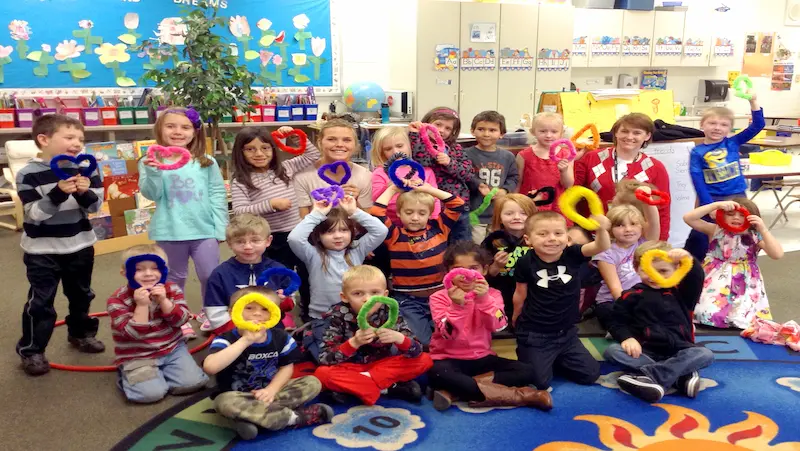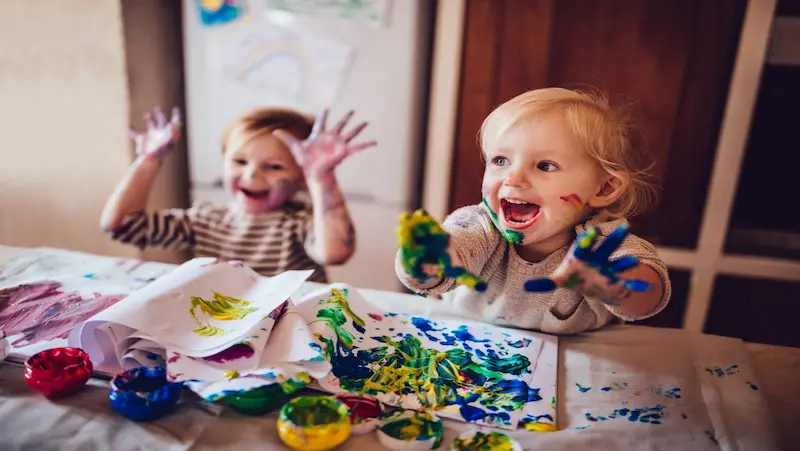In the colorful world of growing up, creativity is like a magic wand that helps children explore, imagine, and learn in extraordinary ways. Just like a garden needs sunlight and water to bloom, children thrive when their creativity is nurtured. From the tiniest tots to the big kids, fostering creativity is like giving them a superpower – it helps them solve problems, think outside the box, and express themselves in unique ways. In this journey of growing up, creativity is not just a bonus; it’s a key ingredient that makes learning an exciting adventure. So, let’s dive into the marvelous world of fostering creativity in children of all ages!
Table of contents
- Why Art is Essential for Child Development?
- Art Activities for Young Children (Ages 3-6)
- Creative Adventures for Elementary School Kids (Ages 7-12)
- Unleashing Creativity in Teens (Ages 13 and Above)
- Nurturing Artistic Talents in Children
- Incorporating Art into Learning: Cross-Curricular Connections
- Conclusion
- Frequently Asked Questions
Why Art is Essential for Child Development?
Art is not just about creating beautiful pictures; it plays a crucial role in the overall development of children. Engaging in art activities offers a myriad of benefits that go beyond the realm of creativity. In this section, we’ll explore why art is essential for the cognitive, emotional, and social development of young minds.

Cognitive, Emotional, and Social Benefits
Cognitive Development:
Art stimulates the brain and encourages critical thinking. When children engage in artistic activities, they are required to make decisions, solve problems, and think creatively. This process helps in the development of cognitive skills such as memory, attention, and spatial awareness. Drawing, painting, and sculpting all contribute to honing these mental abilities.
Emotional Development:
Expressing oneself through art provides an emotional outlet for children. It allows them to convey feelings, whether joy, sadness, or excitement, in a non-verbal manner. This emotional expression is vital for developing self-awareness and emotional intelligence. Art serves as a safe space for children to explore and understand their emotions, fostering a healthy emotional well-being.
Social Development:
Art activities often involve collaboration and sharing. When children create art together, they learn to communicate, negotiate, and work as a team. Group art projects can enhance social skills, teaching children to respect others’ ideas, take turns, and appreciate diverse perspectives. These social interactions contribute significantly to the development of interpersonal skills crucial for later stages of life.
Enhancing Various Skills through Art
Fine Motor Skills:
Engaging in art, whether it’s drawing, cutting, or molding, requires precise hand movements. These activities promote the development of fine motor skills, which are essential for tasks like writing, buttoning clothes, and using utensils. The small, controlled movements involved in art contribute to the refinement of hand-eye coordination.
Language Skills:
Art provides a platform for children to express themselves verbally. As they discuss their creations, describe colors, and narrate their thoughts, they enhance their language skills. This verbal expression not only aids in vocabulary development but also improves communication abilities, helping children articulate their ideas more effectively.
Problem-Solving Skills:
Art encourages experimentation and innovation. When faced with challenges in their artistic endeavors, children learn to think creatively and find solutions. This problem-solving aspect of art is transferable to other areas of life, fostering a mindset that embraces challenges with confidence and resourcefulness.
Art Activities for Young Children (Ages 3-6)
Art is a wonderful way for people of all ages to express themselves and explore their creativity. Whether you’re setting up a creative space at home or in a classroom, the environment plays a crucial role in fostering artistic inspiration. Here are some simple tips to help you design an art-friendly space and choose the right art supplies for different age groups.

Tips on Designing a Creative Space:
1. Choose a Well-Lit Area: Ensure that your art space is well-lit with natural or artificial light. Good lighting not only helps in seeing colors accurately but also creates a positive and inviting atmosphere.
2. Keep It Organized: A tidy space leads to a clearer mind. Organize art supplies in containers or shelves to make it easy for artists to find what they need. This also encourages responsibility and care for the tools.
3. Include Comfortable Seating: Whether it’s a cozy corner at home or a dedicated art class in school, comfortable seating is key. This helps artists focus on their creations without distractions.
4. Incorporate Inspirational Decor: Hang up artwork, quotes, or images that inspire creativity. A visually stimulating environment can spark the imagination and motivate artists to try new things.
Recommendations for Art Supplies Suitable for Different Age Groups:
Young Kids (3-6 years):
1. Finger Paints: Safe and easy to use, finger paints are perfect for young children to explore colors and textures.
2. Large Crayons: Easy to grip and harder to break, large crayons are ideal for developing fine motor skills.
Children (7-12 years):
1. Watercolor Sets: Watercolors are versatile and easy to clean, making them great for children to experiment with different painting techniques.
2. Colored Pencils: A more controlled option for coloring, colored pencils are suitable for detailed work.
Teens and Adults:
1. Acrylic Paints: Versatile and vibrant, acrylic paints offer a wide range of possibilities for both beginners and experienced artists.
2. Sketchbooks: Quality sketchbooks provide a dedicated space for artistic exploration, from doodles to more intricate drawings.
Creative Adventures for Elementary School Kids (Ages 7-12)
Engaging in art activities not only sparks their imagination but also enhances their sensory exploration and basic motor skills. In this section, we’ll explore a variety of simple and age-appropriate art projects tailored specifically for young children aged 3 to 6.

Simple and Age-Appropriate Art Projects:
1. Fingerprint Fun: Let those little fingers do the talking! Provide washable, non-toxic ink pads and let your child create magical creatures, flowers, or even a family tree using their fingerprints. This not only encourages creativity but also helps them develop fine motor skills.
2. Paper Plate Pals: Turn ordinary paper plates into extraordinary characters! With some glue, colored paper, and googly eyes, your child can transform a simple paper plate into their favorite animal or a fantastical creature from their imagination.
3. Nature Collage: Take a nature walk and collect leaves, twigs, and flowers. Back home, let your little one arrange their findings on a piece of paper using non-toxic glue. This activity not only encourages creativity but also instills a love for the outdoors.
Emphasizing Sensory Exploration and Basic Motor Skills:
1. Sensory Paint Play: Mix things up by adding a twist to traditional finger painting. Use textured materials like sand, rice, or fabric scraps to add a sensory element to the painting process. This not only stimulates their senses but also enhances their tactile skills.
2. Playdough Palooza: Homemade playdough is a fantastic way to engage your child’s senses. Let them squish, squeeze, and mold their very own playdough creations. Add natural scents like vanilla or lavender for an extra sensory experience.
3. Stringing Beads: Boost fine motor skills by introducing bead stringing. Provide large, colorful beads and a string. Your child can create their unique jewelry or even practice making patterns with different shapes and colors.
Unleashing Creativity in Teens (Ages 13 and Above)
As teenagers navigate the rollercoaster of adolescence, providing them with avenues for self-expression and creativity becomes crucial. In this section, we’ll explore advanced art projects tailored for teens aged 13 and above, aiming to stimulate their creativity and foster emotional well-being.

Advanced Art Projects for Teens
1. Mixed Media Masterpieces: Encourage teens to experiment with various art materials like acrylics, watercolors, and even unconventional items like fabric and newspaper. Combining these elements can lead to unique and visually striking creations.
2. Digital Art Exploration: Introduce teens to the world of digital art using graphic design tools or tablet applications. This not only hones their artistic skills but also keeps them engaged in the ever-evolving digital landscape.
3. Sculpture Challenges: Move beyond traditional sculpture by incorporating found objects into three-dimensional creations. This not only tests their problem-solving skills but also broadens their understanding of art in different forms.
4. Street Art-Inspired Murals: Take art beyond the canvas by allowing teens to create murals. This collaborative project fosters teamwork and community spirit while giving them the opportunity to make a lasting impact in their environment.
The Role of Art in Teenagers’ Lives
Art isn’t just about creating beautiful pieces to hang on a wall; it’s a powerful tool for self-expression and emotional well-being, especially for teenagers. Here’s why:
1. Emotional Outlet: Art provides a safe space for teens to express complex emotions that might be difficult to convey verbally. Whether it’s through vibrant colors, abstract shapes, or poignant imagery, art allows them to communicate and process their feelings.
2. Identity Exploration: Adolescence is a period of self-discovery, and art serves as a mirror reflecting their evolving identity. Teens can use art to explore different facets of themselves and communicate their experiences to others.
3. Stress Relief: The pressures of school, social life, and future uncertainties can be overwhelming. Engaging in art projects offers a therapeutic release, allowing teens to momentarily escape and focus on the creative process.
4. Building Confidence: Completing challenging art projects fosters a sense of accomplishment and boosts self-esteem. As teens see their ideas materialize, they gain confidence in their abilities, which can positively impact other areas of their lives.
Nurturing Artistic Talents in Children
Artistic expression goes beyond creating beautiful paintings or catchy tunes; it fosters creativity, boosts confidence, and provides an avenue for self-discovery. Here are some simple yet effective ways to identify and support children with a keen interest in art, along with tips for parents and educators to encourage and nurture these budding talents.

Identifying and supporting children with a keen interest in art:
Observation is Key:
Start by observing your child’s activities and interests. Some children naturally gravitate towards drawing, coloring, or crafting. Pay attention to their preferred activities during playtime.
1. Encourage Exploration: Provide a variety of art supplies and let them experiment with different mediums. From crayons and watercolors to clay and recycled materials, giving them options allows them to discover what they enjoy the most.
2. Notice Patterns: Look for consistent patterns in their choices. If they are frequently doodling in their notebooks or sculpting with playdough, it might be a hint that they have a special interest in the artistic realm.
3. Ask Open-ended Questions: Engage them in conversations about their creations. Ask open-ended questions like, “What inspired you to draw this?” or “Tell me about the story behind your artwork.” This not only helps you understand their artistic inclinations but also encourages them to express their thoughts.
Tips for parents and educators to encourage and nurture artistic talents:
1. Create a Supportive Environment: Foster an environment where creativity is celebrated. Display their artwork proudly and encourage discussions about different art forms. This positive reinforcement motivates them to continue exploring their artistic side.
2. Provide Resources: Invest in quality art supplies and materials. Having access to a variety of tools can inspire creativity and allow them to experiment with different techniques. It doesn’t have to be expensive – even simple materials can spark imagination.
3. Enroll in Art Classes: If the interest is evident, consider enrolling your child in art classes or workshops. This provides them with structured learning, exposure to various art styles, and the opportunity to interact with like-minded peers.
4. Celebrate Individuality: Every child has a unique artistic voice. Avoid comparing their work to others. Instead, celebrate their individuality and encourage them to embrace their own style and ideas.
5. Patience and Encouragement: Artistic development takes time. Be patient and offer continuous encouragement. Even if their creations seem unconventional, focus on the effort and creativity they put into their work.
Incorporating Art into Learning: Cross-Curricular Connections
One exciting avenue that has gained popularity is the incorporation of art into various subjects, creating cross-curricular connections that not only engage students but also foster a well-rounded education.

The Art of Integration: Beyond the Classroom Walls
Gone are the days when art was confined to the art room. Now, educators are discovering the incredible potential of infusing creativity into other subjects, turning ordinary lessons into vibrant and engaging experiences. Imagine a world where math becomes a canvas for geometric masterpieces, science lessons transform into colorful experiments, and history takes shape through visual storytelling.
1. Math Marvels: Geometric Art
Mathematics and art may seem like an unlikely pair, but the fusion of these two disciplines can spark a newfound appreciation for both. Students can explore the symmetry of shapes, delve into tessellation, and create mesmerizing patterns using mathematical concepts. This not only makes math more enjoyable but also encourages a deeper understanding of geometric principles.
2. Scientific Canvases: Art Meets Science
Science comes to life when art becomes its companion. From crafting models of cells to illustrating the water cycle, students can visually represent scientific phenomena through artistic projects. This hands-on approach allows them to grasp complex scientific concepts in a memorable and enjoyable way.
3. History Unveiled: Visual Storytelling
History can sometimes be a challenge to grasp, but incorporating art into historical lessons can make the past come alive. Students can create visual timelines, historical maps, or even reenact scenes from different eras. This not only deepens their understanding of historical events but also nurtures their creativity.
Conclusion
In conclusion, encouraging creativity in kids through art is like planting seeds for a vibrant garden. It helps them blossom into imaginative individuals, capable of thinking outside the box. Art isn’t just about colors and shapes; it’s a playground where kids learn to express themselves, solve problems, and discover the joy of creating something unique. By fostering creativity, we empower children to embrace their uniqueness and build a foundation for a future filled with innovation and self-expression. So, let’s continue to nurture their creative spirits, for in doing so, we’re sowing the seeds of a brighter and more imaginative tomorrow.
To get your hands on more such articles, educational content, and free resources on coding classes for kids, online robotics classes for kids, game development, etc., check out the BrightCHAMPS Page now!
Frequently Asked Questions
A2. Art helps children develop essential skills like creativity, problem-solving, and self-expression.
A2. You can encourage creativity by providing them with art supplies, offering diverse art experiences, and praising their efforts.
A3. You can start introducing art to children as young as toddlers. It’s never too early to let them explore their creativity.
A4. Simple activities like finger painting, coloring, and drawing with crayons are great ways to start.
A5. Nurturing creativity can lead to improved problem-solving skills, enhanced self-esteem, and a love for learning.
A6. Encourage their interests, provide access to art classes or materials, and visit museums or galleries to inspire them.


 We are an army of educators and passionate learners from BrightChamps family, committed to providing free learning resources to kids, parents & students.
We are an army of educators and passionate learners from BrightChamps family, committed to providing free learning resources to kids, parents & students.








